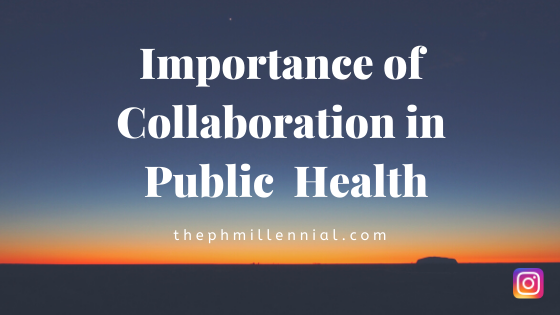Collaboration in public health plays a large role in successfully improving population health. This can be done through programs, initiatives, coalitions and much more. Since public health is a vast field, spanning many disciplines and fingers reaching into various other fields, successful collaboration skills are a must.
Whether you are a student, academic, professional or an organization, collaboration will come into play in one way or another in during your career.
Promoting and maintaining population health has always required efforts from various sectors in a given community. As each sector plays its specific role in addressing and improving population health.
Understanding the role collaboration plays in public health is vital to your ongoing success throughout your career. Beginning to develop this during your coursework and experiences can truly help you to better apply yourself.
Support The Public Health Millennial on BuyMeACoffee

(Related: 4 Things I Wish I Did During Graduate School (MPH))
What is Collaboration in Public Health
Collaboration refers to the relationship where two or more independent parties voluntarily choose to work together to address a common issue. The skill of collaboration is learnt through coursework and is further developed as one enters into the workforce. It is an essential skill to develop as a public health professional as it will more than likely be a part of your job role.
Collaboration can come in many forms, such as:
- Informal project collaboration
- Collaboration for grant funds
- Formation of alliances or coalitions
- Multi-sector collaboration on health assessments
Multidisciplinary approaches are becoming more common in furthering population health. It’s important to note that collaboration can happen between various types of agencies related to health. For example, this can be a local public health department collaborating with the health system, school district, local businesses, federal agencies and much more.
You can see collaboration through grant proposals, public policy & community directed goals and implementation plans to address assessed community issues.
Public health systems tend to be complex. Thus approaching various agencies impacting the system is vital to holistic community health improvement. Taking a systems approach requires that different agencies collaborate to do their part to impact the part of the system that aligns with their agencies role.
(Related: How to Find an Out of State Internship)
Policies for Collaboration
The Internal Revenue Service (IRS) now requires tax-exempt hospitals to conduct community health needs assessment every three years. These assessments usually require cross-collaboration from community members and agencies, including public health departments and other agencies to represent the needs of the broad community.
Additionally, the IRS requires that the community agencies come together to develop an implementation plan to address the prioritized needs of the community that were identified through the assessment process. This further engages collaboration. This ‘forced’ collaboration by the government was created in order to better address community health issues by approaching the issue from a diversity of perspectives. Which truly gives birth to systematic community health improvements rather than siloed services and approaches.
Also collaboration can be viewed is through the lens of health foundations and other funders. Typically, you will see funders aim to collaborate on the funding projects instead of independent funding. Funders are usually looking to see what other agencies grantees have secured financial commitments from to better leverage their funding. This allows for a community environment where many different agencies have a vested interest in various cross-cutting projects. Another, huge part of this is when grantees are able to leverage matching funds from either state or federal government. This is beneficial as it aims to successfully develop programs that are more likely to be sustainable into the future as there are leveraged funds from outside of the community.

Why Collaboration is Important to Public Health
Inter-Organizational
The United States continues to spend approximately 18% of its GDP on healthcare. As this issue continues to persist, it has become evident that new approaches are needed to be developed to better practice, organize and serve our communities. These approaches are going to be driven more and more by collaborative efforts aiming to improve population health.
Public health is about systems. No issue happens independently of another, there is always a connection. And thus, approaches to improving population health can’t take place in a silo. When organizations operate in silos as oppose to in a collaborative manner, the system fails to address the issues it faces in the best way possible. The collaboration that occurs between organizations allows for a bigger impact to take place in regard to addressing an issue. It allows for conversations that will help to fully understand the issues, perspectives, and approaches that will be necessary to have a major impact on the issue at hand.
Another reason collaboration is important is for health equity. Having diverse voices at the table ensures that specific sub-populations concerns can be brought into the conversation around improving health. For example, how can one know the concerns of the LGBTQ+ community when it comes to the opioid epidemic, if there is no representation from individuals or agencies that serve this population? Public health professionals should always aim to understand how issues affect all the various sub-populations in a given community. This is important to ensure there are strategies to address these issues from diverse perspectives.
Collaboration also plays a role in de-duplicating services in a given community. By understanding where there is overlap from different organizations, only then can effective approaches be developed to best address an issue from a full continuum of care approach.
Intra-Organizational
Not only is collaboration important from a system (inter-organizations) level, it is also hugely important at intra-organization level. The different professionals at each organization are all hired for different roles, for the most part. Teamwork and the team culture throughout an organization can have an impact on the fulfillment of employees and plays a part in successful organizations.
In a study done by Visix:
- 86% of employees and executives cite lack of collaboration or ineffective communication for workplace failures
- 49% of Millennials support social tools for workplace collaboration
- 39% of surveyed employees believe that people in their own organization don’t collaborate enough.
This study shows that intra-organization collaboration plays a huge role in how the workplace will be shifted to one that supports more collaboration. This can be seen as many more collaborative apps take the workforce such as Slack or Monday.com.
I recently watched a YouTube video of Samsung’s new building. You can see the importance of collaborative workspace that allows for more social connection will be a model for future organizations.
(Related: How To Setup An Effective LinkedIn Profile)

Challenges in Developing Collaboration
Though collaboration can be seen as an important factor for success, it has not become commonplace in many organizations. There are many challenges when it comes to developing collaborative work within or among organizations.
Firstly
There can be a misalignment in the incentives or visions of various organizations or roles in an organization. For example, a health foundation may be trying to imporove the health of community members to decrease the amount of unnecessary Emergency Admissions. But at the same time a local hospital may be incentive to have generate more admission in order to hit revenue goals (granted they are still in the fee-for-service model still). As you can see there is clear misalignment between this organizations. This can be a true barrier to successful collaboration for improved population health.
Secondly
Health and public health systems are very complex. Affecting and improving one part of the system can have unintended impacts on other parts of the system. A systems approach to public health is essential but is does come with its challenges. For example, increasing access to medical marijuana to reduce the opioid prescriptions can lead to more youth accessing and using marijuana. Which then brings up its own concerns. Even when you think you are collaborating and making positive impacts on a given factor this can show up with new issues in other areas.
Lastly
There is a shear lack of data around the evaluation around public health collaboration. In a study at the beginning of the decade done by NCBI, evaluation of 661 multisector public health partnerships created to improve community health only showed that 45% of them were successful. It goes without saying that public health is a field that thrives on evaluation. Thus, there needs to be better systems in place to evaluate how various multisector partnerships are impacting population’s health. This will be important to understand which collaborative structures can be best used to address various public health issues. I will note there has been partnership models that have been shown to be impactful such as the collective impact model.
(Related: 6 Months at My Public Health Fellowship | 5 Lessons)
How To Build Collaboration in Public Health
Collaboration is a skill that can be developed and built upon. This is both for indiivudals and for agencies.
As a student
Public health students should strive to develop their collaborative skills. This can be through group projects, taking part in case competitions, taking leadership roles in academic/community organizations. Even in school you will realize that different individuals have different perspectives on issues by virtue of their lived experiences and academic background. This diversity in perspectives should be viewed as a strength and should be promoted to find inclusive solutions.
Students can simply look to build collaborative skills by asking:
- What do you think of this?
- Are there any potential negative consequences that we haven’t thought of?
As a professional
Public health professionals need to view communication and collaboration as important skills to drive the work they are doing. This can be accomplished by having open-minded conversations where everyone’s perspective is valued. By having these conversations with colleagues, you get to better understand your colleagues and how you can use their knowledge and skills to best inform the work you are doing.
The one word I have to put out to professionals to develop this skill is: attitude. There is much to be gained from having an attitude that allows you to incorporate collaboration into your daily work. This includes building trust with coworkers and other agency stakeholders. Additionally, having an open mind to innovative and different perspective and solutions presented to a specific problem.
As an organization
Organization have the difficult task of having to both collaborate intra-organizationally as well as inter-organizationally. The first step for an organization to develop collaborative skill is by developing it into the culture of the workplace. Create policies that support hearing from diverse voices on issues and working together to find solutions.
A major part of having successful inter-organizational collaboration is by being clear on the roles and responsibilities of the various stakeholders. You will want to ensure that everyone is on the same page. Ensuring that trust and respect is developed for inter-organization collaboration to have its greatest impact. Having a shared vision and goals can be a great start to developing the needed collaboration to be successful in addressing complex population needs. This can be done by establishing a collective impact model to drive the work you are doing.
There is also a need to have authentic partnership. By this I mean that you need organizations at the table not because of obligation but because they are passionate about addressing the issue at hand.

Conclusion
As public health professionals, collaboration continues to play a large role in our roles. Developing your collaboration skill will proof beneficial in your performing your role even better.
Since the public health field deals with complex problems that require inter-organization solutions, having this skill in your toolbox will prepare you to better serve the populations you are passionate about.
As a student, you can foster greater understanding of this skill by being proactive in group settings and by pushing to work in projects that require diverse fields of knowledge to solve the issue.
How have you fostered greater collaboration?



